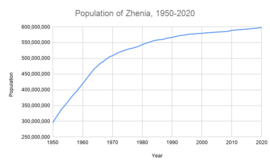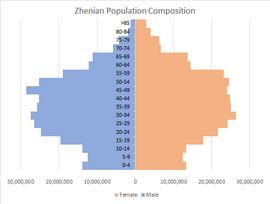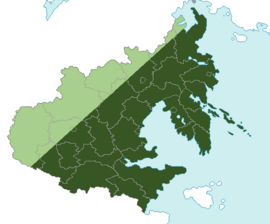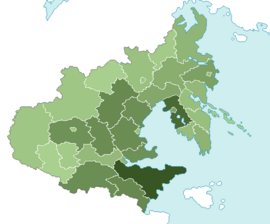Demographics of Zhenia: Difference between revisions
No edit summary |
mNo edit summary |
||
| (One intermediate revision by the same user not shown) | |||
| Line 49: | Line 49: | ||
[[File:Bukju-Ariul-Munsan Line Zhenia Demographics.png|270px|thumb|right|The [[Bukju-Ariul-Munsan Line]] exemplifies the concentration of Zhenia's population distribution in eastern, central and southern Zhenia.]] | [[File:Bukju-Ariul-Munsan Line Zhenia Demographics.png|270px|thumb|right|The [[Bukju-Ariul-Munsan Line]] exemplifies the concentration of Zhenia's population distribution in eastern, central and southern Zhenia.]] | ||
As one of the most populous nations in Tarsis, Zhenia is relatively densely populated, with around 111.6 people per km<sup>2</sup>; a vast majority of them, however, are relatively are focused in the relatively habitable eastern, central and southern regions of the nation. This is well-exemplified by the fact that around 96% of the nation's entire population lives east of the [[Bukju-Ariul-Munsan Line]], with the area east of the line accounting for almost all of the nation's arable land. Over half of the nation's population is concentrated on the [[Golden Arc]] region around the [[Gulf of Danguk]], spanning from [[Balhae Province|Balhae]] to [[Namhae Province|Namhae Province]], despite only accounting for around 24% of the nation's entire area. | As one of the most populous nations in Tarsis, Zhenia is relatively densely populated, with around 111.6 people per km<sup>2</sup>; a vast majority of them, however, are relatively are focused in the relatively habitable eastern, central and southern regions of the nation. This is well-exemplified by the fact that around 96% of the nation's entire population lives east of the [[Bukju-Ariul-Munsan Line]], with the area east of the line accounting for almost all of the nation's arable land. Over half of the nation's population is concentrated on the [[Golden Arc]] region around the [[Gulf of Danguk]], spanning from [[Balhae Province|Balhae]] to [[Namhae Province|Namhae Province]], despite only accounting for around 24% of the nation's land area. Some of the most densely populated areas, including the [[Taimir River Delta megalopolis|Taimir River Delta]], [[Central Danguk megalopolis|Central Danguk Peninsula]] and the [[Western Gulf megalopolis|Western Gulf]] regions, have developed into {{wp|megalopolis|megalopolises}}, covering vast urban areas dense in population. | ||
Zhenian population is considerably more scarce in western and, to an extent, northern Zhenia due to its relatively harsh terrain and climate. [[Heuksu Province|Heuksu]] and [[Shingang Province|Shingang Provinces]], both the largest and second-largest provinces in Zhenia by area, are together only home to around 1.7% of the nation's population despite accounting for around 18% of the nation's entire area. Western and northern Zhenia are also home to fewer cities and metropolitan areas than the remainder of the nation, being home to only one [[Administrative divisions of Zhenia#Metropolitan Municipalities|metropolitan municipality]] ([[Ariul]]) and being home to only two cities outside [[Seogwang Province]] with a population of over 1 million, ([[Jangsan]] and [[Naseon]]). | |||
==Vital Statistics== | ==Vital Statistics== | ||
| Line 60: | Line 62: | ||
==Ethnic Groups== | ==Ethnic Groups== | ||
Of the 598,011,689 people in Zhenia, [[Jin Zhenian|Jin Zhenians]], a union between [[Dan Zhenian|Dan]] and [[Wei Zhenian|Wei Zhenians]], form around 87% of the population, as the largest ethnic group in the nation. While Dan and Wei Zhenians have remained historically and genetically different, assimilation policies in place since the [[Empire of Zhenia]], as well as significant Dan Zhenian migration into the mainland, has diluted a considerable portion of such differences, although they are still officially counted separately. While Wei Zhenians can be further divided into smaller subsets of ethnic and cultural groups by region, both Dan and Wei Zhenians are often referred to as Jin Zhenians, as a primarily political attempt to emphasize unity within the nation. | |||
Aside from Dan and Wei Zhenians, the Republic of Zhenia officially recognizes 51 additional distinct ethnic groups that exist in the nation, which altogether account for the remaining 13% of the population. Some of the largest ethnic minority groups in Zhenia include the [[Yemeg Zhenian|Yemeg]] (25.7 million, 4.3%), [[Balakhaat Zhenian|Balakhaat]] (21.2 million, 3.5%), [[Haedong Zhenian|Haedong]] (9.6 million, 1.6%) and [[Zihara Luhan|Zihara Luhani]] (4.1 million, 0.68%). There are 2.1 million westerners of northern [[Veharia|Veharian]] and [[Aurora (continent)|Auroran]] origin, while around 1.1 million {{wp|mestizos}} from former Zhenian colonies reside in Zhenia. | |||
==Languages== | |||
==Religions== | ==Religions== | ||
==Migration== | ==Migration== | ||
==Demographic Statistics== | ==Demographic Statistics== | ||
Latest revision as of 04:30, 10 April 2020
| Demographics of Zhenia | |
|---|---|
 Population of Zhenia from 1950 to 2020. | |
| Population | |
| Growth rate | |
| Birth rate | 10.4 per 1,000 (2020) |
| Death rate | 8.3 per 1,000 (2020) |
| Life expectancy | |
| • male | |
| • female | |
| Fertility rate | 1.56 children per woman (2020) |
| Infant mortality rate | 2.87 deaths per 1000 live births (2020) |
| Age structure | |
| 0–14 years | 13.27% (2020) |
| 15–64 years | 77.01% (2020) |
| 65 and over | 9.73% (2020) |
| Sex ratio | |
| At birth | 1.032 male to female (2020) |
| Under 15 | 1.023 male to female (2020) |
| 15–64 years | 0.977 male to female (2020) |
| 65 and over | 0.728 male to female (2020) |
| Nationality | |
| Nationality | noun: Zhenian adjective: Zhenian |
| Major ethnic | Jin Zhenian |
| Minor ethnic | Yemeg, Balakhaat, Haedong, Zihara Luhani, other minor groups |
| Language | |
| Official | Standard Zhenian |
Zhenia is one of the most populous nations in Tarsis, with a estimated population of 598,011,689 as of January 1, 2020. The Republic of Zhenia Bureau of Statistics has reported a population increase of 0.25% from the previous year, showing a relatively unexpected increase in the population change rate. The total fertility rate in Zhenia is estimated at 1.56 children per woman as of 2020, a gradual decrease from 2.1 children per woman in 2020 and below the replacement fertility rate of around 2.1. Despite declining fertility rates, the overall population of Zhenia is set to increase at least until 2050, due to the gradual decrease in mortality rates and the continued influx of immigrants.
Historically, the Zhenian population has doubled for the past seventy years, from around 290 million in 1950 to almost 600 million as of 2020, with a bulk of its population growth occurring between the 1950s and 1970s. Natural population growth has stalled in the Danguk Peninsula in general, with internal migration primarily driving population growth in the region, while natural population growth tends to be higher in mainland provinces in Central Zhenia in general, with a fertility rate of around 2.2 observed in Central Zhenia.
Jin Zhenians, defined as the union between Dan and Wei Zhenians, constitute a vast majority of the nation's population, with a total of about 520,389,916 or 87% of the nation's population as of 2020. They are followed by Yemeg Zhenians who constitute around 4.3% of the population, the Balakhaat and Haedong Zhenians following them at 3.6% and 1.6% of the population respectively, among other ethnic minorities across the nation. While many ethnic minorities identify themselves as non-Jin Zhenian, a significant portion of them are culturally closer to Jin Zhenians in culture, using Standard Zhenian as their first language.
Although population growth is expected to slow down over the years, further decreases in the mortality rate as well as continued immigration are expected to drive the increase in population, with estimates that the nation's population would reach the 600 million mark by 2022, reach 630 million in 2035 and potentially top off at around 670 million by 2080 if the current trends continue. A significant portion of the increase is expected to be from immigration and ethnic minorities, the latter of which have been generally exempt from most government-level population control policies since the Fourth Republic.
Population
Historical population
Census data

Population density and distribution

As one of the most populous nations in Tarsis, Zhenia is relatively densely populated, with around 111.6 people per km2; a vast majority of them, however, are relatively are focused in the relatively habitable eastern, central and southern regions of the nation. This is well-exemplified by the fact that around 96% of the nation's entire population lives east of the Bukju-Ariul-Munsan Line, with the area east of the line accounting for almost all of the nation's arable land. Over half of the nation's population is concentrated on the Golden Arc region around the Gulf of Danguk, spanning from Balhae to Namhae Province, despite only accounting for around 24% of the nation's land area. Some of the most densely populated areas, including the Taimir River Delta, Central Danguk Peninsula and the Western Gulf regions, have developed into megalopolises, covering vast urban areas dense in population.
Zhenian population is considerably more scarce in western and, to an extent, northern Zhenia due to its relatively harsh terrain and climate. Heuksu and Shingang Provinces, both the largest and second-largest provinces in Zhenia by area, are together only home to around 1.7% of the nation's population despite accounting for around 18% of the nation's entire area. Western and northern Zhenia are also home to fewer cities and metropolitan areas than the remainder of the nation, being home to only one metropolitan municipality (Ariul) and being home to only two cities outside Seogwang Province with a population of over 1 million, (Jangsan and Naseon).
Vital Statistics
Labor force
Height and weight
Gender balance
Ethnic Groups
Of the 598,011,689 people in Zhenia, Jin Zhenians, a union between Dan and Wei Zhenians, form around 87% of the population, as the largest ethnic group in the nation. While Dan and Wei Zhenians have remained historically and genetically different, assimilation policies in place since the Empire of Zhenia, as well as significant Dan Zhenian migration into the mainland, has diluted a considerable portion of such differences, although they are still officially counted separately. While Wei Zhenians can be further divided into smaller subsets of ethnic and cultural groups by region, both Dan and Wei Zhenians are often referred to as Jin Zhenians, as a primarily political attempt to emphasize unity within the nation.
Aside from Dan and Wei Zhenians, the Republic of Zhenia officially recognizes 51 additional distinct ethnic groups that exist in the nation, which altogether account for the remaining 13% of the population. Some of the largest ethnic minority groups in Zhenia include the Yemeg (25.7 million, 4.3%), Balakhaat (21.2 million, 3.5%), Haedong (9.6 million, 1.6%) and Zihara Luhani (4.1 million, 0.68%). There are 2.1 million westerners of northern Veharian and Auroran origin, while around 1.1 million mestizos from former Zhenian colonies reside in Zhenia.

